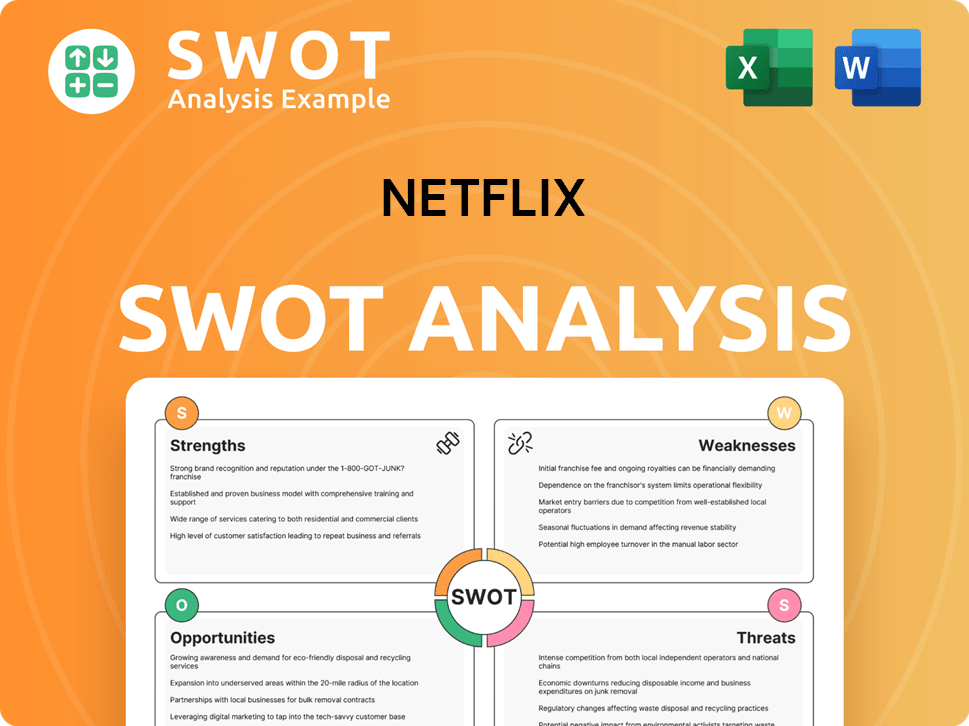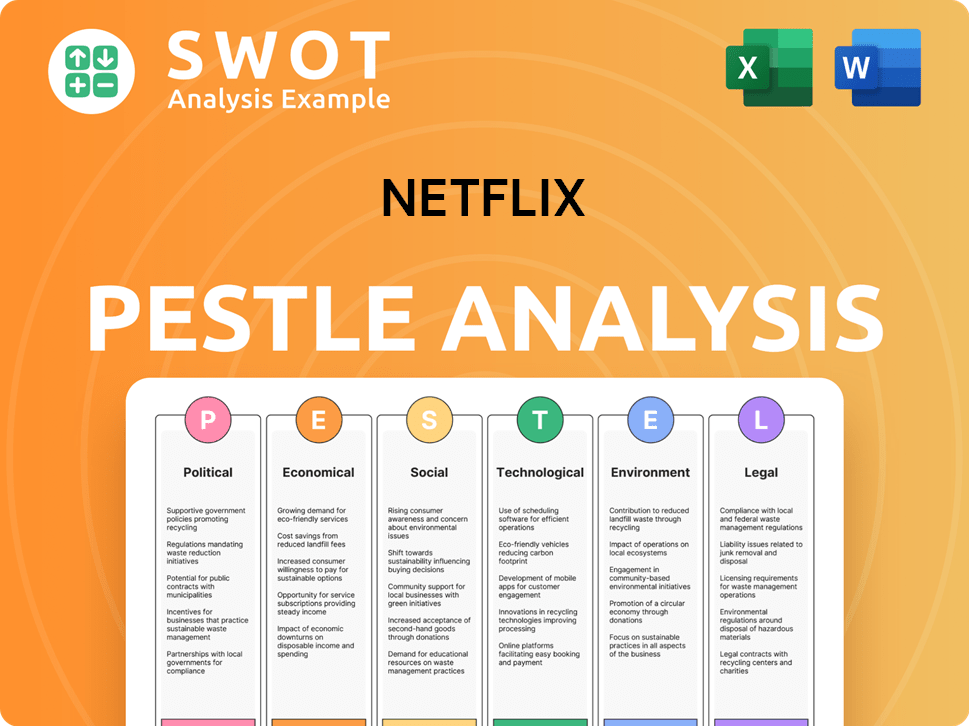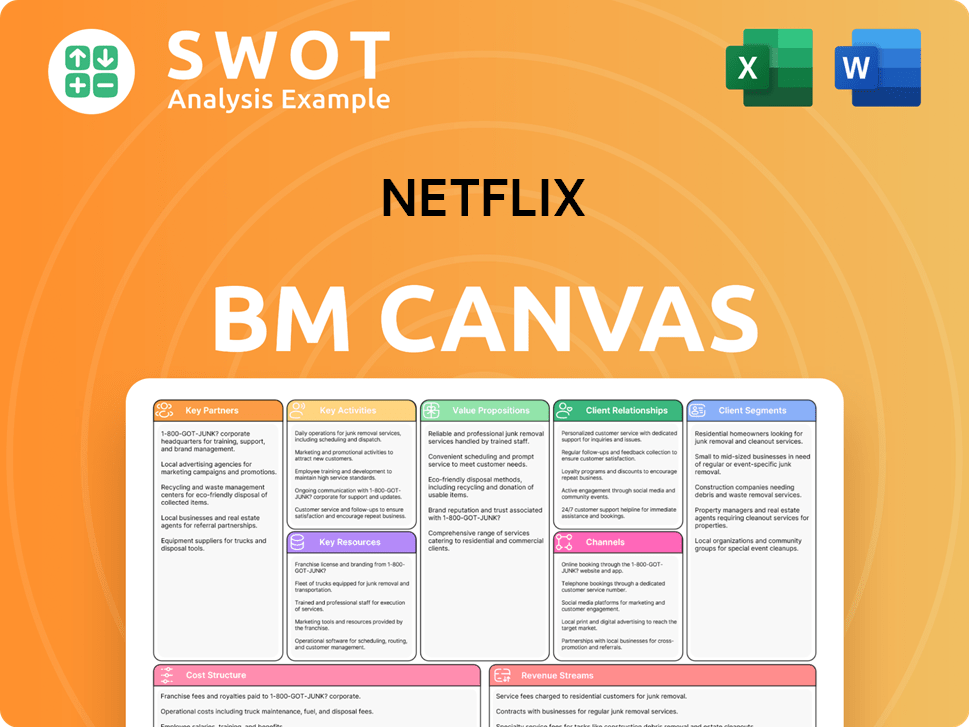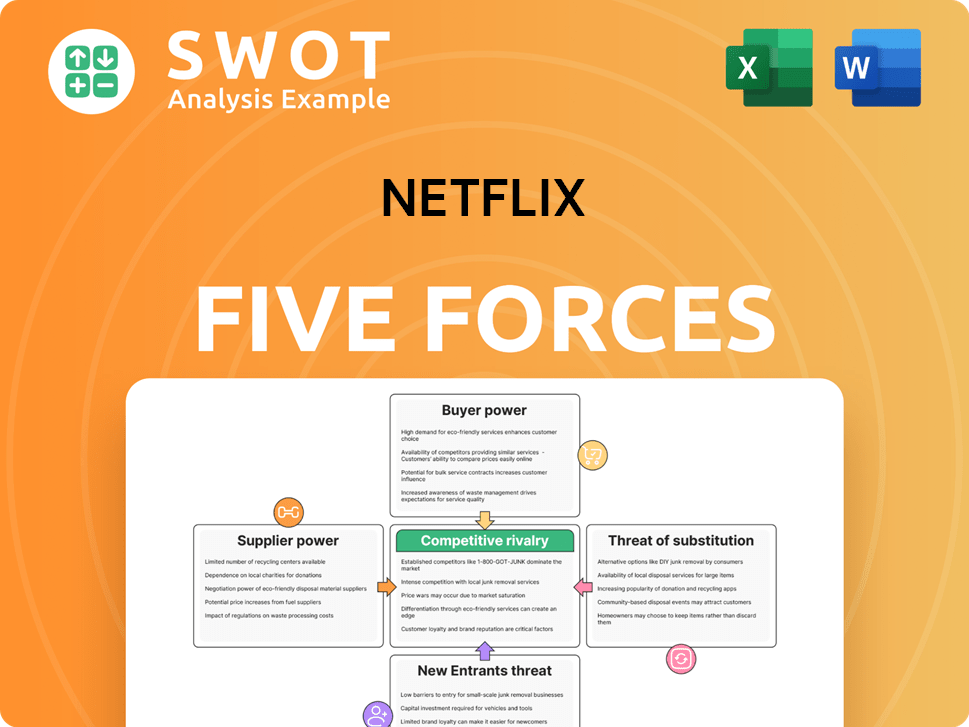Netflix Bundle
How Did Netflix Conquer the World?
From a simple DVD rental service to a global streaming giant, Netflix's Netflix SWOT Analysis reveals a fascinating tale of innovation and strategic prowess. Imagine a world before binge-watching, where late fees and limited selections were the norm. This is the backdrop against which Netflix, the Netflix company, began its remarkable journey.

Delving into the Netflix history unveils a story of bold moves, from its Netflix origin in 1997 to its pivotal shift to the Netflix streaming service in 2007. This article explores the Netflix timeline, examining its evolution and the key decisions that propelled it to become a dominant force in the entertainment industry. Discover how Netflix changed entertainment and its impact on the film industry.
What is the Netflix Founding Story?
The Netflix history began on August 29, 1997, when Reed Hastings and Marc Randolph established the company in Scotts Valley, California. Their vision was to revolutionize the home-video rental market, which was then dominated by brick-and-mortar stores and plagued by late fees. Hastings, a computer scientist, and Randolph, a marketing director, saw an opportunity to disrupt the industry.
The
The initial business model, launched in April 1998, was a DVD-by-mail service. This was a novel concept at the time, given that VHS tapes were the dominant format. Customers could select DVDs online and receive them via postal services. The founders tested the viability of mailing compact discs, and upon successful delivery, decided to enter the home-video rental industry. Netflix initially offered a per-rental model but quickly transitioned to a monthly subscription service in September 1999, allowing unlimited rentals for a flat fee. Hastings provided the initial capital and funding for the company, amounting to $2.5 million from the sale of his previous company, Pure Software. The name 'Netflix' was chosen in 1998, reflecting the founders' belief that internet-based movie rental was the future.
Here are some key milestones in the early days of Netflix:
- August 29, 1997: Netflix is founded by Reed Hastings and Marc Randolph.
- April 1998: The DVD-by-mail service is launched.
- September 1999: Netflix transitions to a monthly subscription model.
- Early Funding: Hastings invested $2.5 million from the sale of his previous company, Pure Software.
Netflix SWOT Analysis
- Complete SWOT Breakdown
- Fully Customizable
- Editable in Excel & Word
- Professional Formatting
- Investor-Ready Format

What Drove the Early Growth of Netflix?
The early years of the Netflix company saw remarkable growth, driven by its innovative subscription model and focus on customer satisfaction. By 2002, the company had already attracted 600,000 subscribers, showcasing its potential. This early success culminated in its initial public offering (IPO) in May 2002, raising $82.5 million. This period set the stage for the company's future in the entertainment industry. The Growth Strategy of Netflix has been a key factor in its success.
A pivotal moment in the Netflix history occurred in 2000 when the company offered to sell itself to Blockbuster for $50 million, an offer that was declined. This decision by Blockbuster would prove to be a significant misstep, as Netflix continued to grow and eventually dominate the DVD rental market. This early strategic move highlighted Netflix's vision.
In January 2007, Netflix launched its streaming media service, marking a significant shift in the Netflix timeline. Initially, the streaming service offered a limited catalog of about 1,000 films, a fraction of the 70,000 available on DVD. This move positioned Netflix as a pioneer in the streaming industry, setting the stage for its future dominance.
The company invested heavily in personalized recommendation algorithms, improving user engagement and satisfaction. The Netflix Prize contest in 2006 further enhanced these algorithms, setting it apart from competitors. This focus on user experience and innovation was a key element of the Netflix evolution.
Netflix began its international expansion in 2010 with its launch in Canada. The company then entered six new European markets in September 2014, including Austria, Belgium, France, Germany, Luxembourg, and Switzerland. This global expansion involved adapting its business model to diverse cultural and regulatory demands. By 2012, roughly one-third of its revenue still came from its DVD-by-mail business.
Netflix PESTLE Analysis
- Covers All 6 PESTLE Categories
- No Research Needed – Save Hours of Work
- Built by Experts, Trusted by Consultants
- Instant Download, Ready to Use
- 100% Editable, Fully Customizable

What are the key Milestones in Netflix history?
The Netflix company history is a story of disruption and innovation in the entertainment industry. From its humble beginnings as a DVD rental service to its current status as a global streaming giant, Netflix has consistently redefined how people consume media. The company's evolution reflects significant strategic pivots and a relentless focus on adapting to changing consumer behaviors and technological advancements, making it a fascinating case study in business innovation.
| Year | Milestone |
|---|---|
| 1997 | Netflix is founded by Reed Hastings and Marc Randolph, initially offering a DVD rental service by mail. |
| 1999 | Netflix introduces a subscription-based DVD rental model, eliminating late fees and offering unlimited rentals. |
| 2007 | Netflix launches its streaming service, marking a major shift towards digital media consumption. |
| 2013 | Netflix begins producing original content with the debut of 'House of Cards,' transforming into a content creator. |
| 2016 | Netflix expands its services globally, becoming available in over 130 countries. |
| 2022 | Netflix introduces an ad-supported subscription tier, expanding its revenue streams. |
Netflix's innovations have consistently reshaped the entertainment landscape. The shift from DVD rentals to streaming was a bold move that transformed the way people access movies and TV shows. Furthermore, the company's investment in original content production, including series like 'Stranger Things' and 'The Crown,' has not only attracted subscribers but also set new standards for content quality and distribution.
This model eliminated late fees and offered unlimited rentals for a flat monthly fee, disrupting the traditional video rental market. This approach provided a convenient and cost-effective alternative to brick-and-mortar stores.
The launch of the streaming service in 2007 was a pivotal moment, enabling instant access to content on various devices. This innovation positioned Netflix as a leader in digital media consumption.
Venturing into original content with 'House of Cards' in 2013 allowed Netflix to control its content library and attract top talent. This shift enhanced its brand status and reduced reliance on licensing.
Netflix's recommendation engine, powered by sophisticated algorithms, has been a key factor in user engagement. This feature enhances the viewing experience by suggesting content tailored to individual preferences.
Netflix's rapid international expansion, making its services available in over 190 countries, has significantly broadened its subscriber base. This global reach has fueled its growth and influence.
The introduction of an ad-supported tier in late 2022 offered a more affordable option, attracting a wider audience. This strategy has boosted subscriber numbers and diversified revenue streams.
Despite its successes, Netflix faces several challenges in a rapidly evolving market. Intense competition from streaming rivals like Amazon Prime Video, Disney+, and others necessitates continuous investment in content and technology. Furthermore, navigating complex regulatory landscapes and varying censorship laws across different countries poses ongoing difficulties.
The streaming market is crowded, with competitors like Amazon Prime, Disney+, and HBO Max vying for subscribers. This competition drives up content costs and requires continuous innovation.
The cost of producing and licensing high-quality content has increased dramatically. This necessitates strategic content investments and efficient cost management to maintain profitability.
Expanding globally requires navigating varying censorship laws, data protection regulations, and tax laws. Compliance with these diverse regulations adds complexity and cost.
Maintaining subscriber loyalty in a competitive market is a constant challenge. Netflix must consistently deliver compelling content and user experiences to reduce churn rates.
Password sharing has historically reduced potential revenue, leading Netflix to implement measures to curb this practice. This has affected subscriber numbers in the short term.
Economic downturns can impact consumer spending on entertainment subscriptions. Netflix must remain resilient and adaptable to maintain its subscriber base during economic fluctuations.
Netflix Business Model Canvas
- Complete 9-Block Business Model Canvas
- Effortlessly Communicate Your Business Strategy
- Investor-Ready BMC Format
- 100% Editable and Customizable
- Clear and Structured Layout

What is the Timeline of Key Events for Netflix?
The Netflix company journey began in 1997, evolving from a DVD rental service to a global streaming giant. Key milestones include the launch of its DVD-by-mail service in 1998, the introduction of a subscription model in 1999, and the shift to streaming in 2007. The company went public in 2002, expanded internationally starting in 2010, and launched its first original series, 'House of Cards,' in 2013, marking a pivotal moment in its
| Year | Key Event |
|---|---|
| 1997 | Founded by Reed Hastings and Marc Randolph in Scotts Valley, California. |
| 1998 | Launched as a DVD-by-mail rental service. |
| 1999 | Introduced a monthly subscription service. |
| 2000 | Offered to sell itself to Blockbuster for $50 million, which was declined. |
| 2002 | Went public with an IPO, raising $82.5 million. |
| 2007 | Launched its streaming media service. |
| 2010 | Began international expansion, starting with Canada. |
| 2013 | Launched its first original series, 'House of Cards.' |
| 2014 | Expanded into six new European markets. |
| 2022 | Introduced an ad-supported subscription tier. |
| 2024 | Generated $39 billion in revenue and had 277.6 million subscribers worldwide. |
| Q1 2025 | Reported $10.54 billion in revenue, a 13% increase year-over-year, and surpassed 300 million global subscribers. |
The company aims to double its 2024 revenue of $39 billion to $78 billion by 2030. Continued international expansion and further development of its ad-supported tier are key drivers. Diversifying content offerings, including live sports and gaming, will also contribute to growth.
Analysts expect revenue to reach between $43.5 billion and $44.5 billion for fiscal year 2025. The operating margin is projected to be around 29-31.7%. The focus is shifting from subscriber growth to emphasizing revenue and operating margin.
Netflix's ability to innovate in content and pricing will be crucial. Maintaining its leadership in the streaming industry is a key objective. The company seeks to stay true to its founding vision of providing easy and enjoyable movie entertainment.
The ad-supported plan accounts for 55% of new sign-ups in enabled markets. This shows the success of the ad-supported tier in attracting new subscribers. This approach is a key part of its strategy for revenue growth.
Netflix Porter's Five Forces Analysis
- Covers All 5 Competitive Forces in Detail
- Structured for Consultants, Students, and Founders
- 100% Editable in Microsoft Word & Excel
- Instant Digital Download – Use Immediately
- Compatible with Mac & PC – Fully Unlocked

Related Blogs
- What is Competitive Landscape of Netflix Company?
- What is Growth Strategy and Future Prospects of Netflix Company?
- How Does Netflix Company Work?
- What is Sales and Marketing Strategy of Netflix Company?
- What is Brief History of Netflix Company?
- Who Owns Netflix Company?
- What is Customer Demographics and Target Market of Netflix Company?
Disclaimer
All information, articles, and product details provided on this website are for general informational and educational purposes only. We do not claim any ownership over, nor do we intend to infringe upon, any trademarks, copyrights, logos, brand names, or other intellectual property mentioned or depicted on this site. Such intellectual property remains the property of its respective owners, and any references here are made solely for identification or informational purposes, without implying any affiliation, endorsement, or partnership.
We make no representations or warranties, express or implied, regarding the accuracy, completeness, or suitability of any content or products presented. Nothing on this website should be construed as legal, tax, investment, financial, medical, or other professional advice. In addition, no part of this site—including articles or product references—constitutes a solicitation, recommendation, endorsement, advertisement, or offer to buy or sell any securities, franchises, or other financial instruments, particularly in jurisdictions where such activity would be unlawful.
All content is of a general nature and may not address the specific circumstances of any individual or entity. It is not a substitute for professional advice or services. Any actions you take based on the information provided here are strictly at your own risk. You accept full responsibility for any decisions or outcomes arising from your use of this website and agree to release us from any liability in connection with your use of, or reliance upon, the content or products found herein.